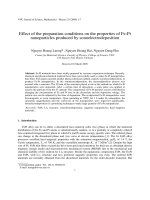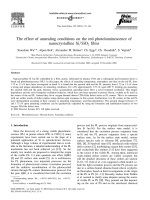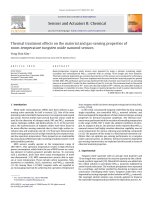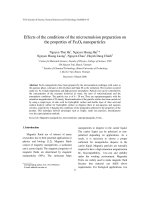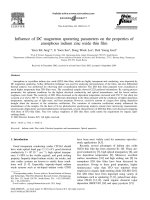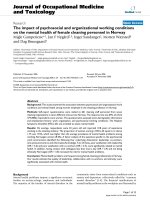Effect of Heat Treatment Conditions on the Properties of FePt Nanoparticles Produced by Sonochemistry
Bạn đang xem bản rút gọn của tài liệu. Xem và tải ngay bản đầy đủ của tài liệu tại đây (281.84 KB, 12 trang )
VNU Journal of Science: Mathematics – Physics, Vol. 31, No. 2 (2015) 15-20
Effect of Heat Treatment Conditions on the Properties of FePt
Nanoparticles Produced by Sonochemistry
Truong Thanh Trung1, Nguyen Thi Thanh Van1
Nguyen Hoang Nam1,2, Nguyen Hoang Luong1,2,*
1
Nano and Energy Center, VNU University of Science, 334 Nguyen Trai, Thanh Xuan, Hanoi, Vietnam
2
Faculty of Physics, VNU University of Science, 334 Nguyen Trai, Thanh Xuan, Hanoi, Vietnam
Received 09 March 2015
Revised 10 April 2015; Accepted 14 April 2015
Abstract: Magnetic properties of magnetic nanoparticles FePt prepared by sonochemistry were
investigated. Upon annealing at temperature from 450ºC to 650ºC samples have ordered L10
structure and show hard magnetic properties. Influence of heat treatment conditions (annealing
temperature, cooling rate) on the magnetic properties of the annealed samples has been studied.
Keywords: FePt, nanoparticle, sonochemistry, magnetic properties.
*
1. Introduction
FePt nanoparticles attract much attention as one of the most promising candidates for ultrahighdensity magnetic recording media because of their superior magnetic properties such as high
magnetocrystalline anisotropy energy, high saturation magnetization and high chemical stability [1,2].
Meanwhile, FePt nanoparticles are also expected to be a high-performance nanomagnet for magnetic
medicine, such as magnetic hyperthermia [3], immunomagnetic cell separation [4], and excellent
contrast agents for magnetic resonance imaging [5].
Usually, FePt nanoparticles fabricated have a disordered face-centered cubic (fcc) structure, and
thus a post thermal annealing is necessary to transform them into the desired ordered face-centered
tetragonal (fct) L1o phase. Recently, magnetic properties of FePt nanoparticles prepared by
sonoelectrodeposition have been reported by Nam et al. [6]. In this study, we report the hard magnetic
properties of FePt nanoparticles synthesized by sonochemistry, which was developed to make
nanoparticles [7]. Influence of heat treatment conditions (annealing temperature, cooling rate) on the
magnetic properties of the annealed samples has been discussed.
_______
*
Corresponding author. Tel.: +84-4-35406125
Email:
15
16
T.T. Trung et al. / VNU Journal of Science: Mathematics – Physics, Vol. 31, No. 2 (2015) 15-20
2. Experimental
The synthesis of FePt nanoparticles was conducted by sonochemical reaction. The mixture of
H2PtCl6 and iron (II) acetate [Fe(C2H3O2)2] with distilled water were prepared in a 150 ml flask in (Ar
+ 5% H2) atmosphere. A little TSC (trisodium citrate) was added to the solution. The solution in flask
was ultrasonicated with power of 375 W, frequency of 20 kHz emitted by a Sonic VCX 750
ultrasound emitter within 240 minutes. The FePt nanoparticles were washed and separated from the
solution by using a centrifuge with alcohol at 9000 rpm for 30 minutes and then dried at 70oC-75oC.
As-prepared samples then were annealed at various temperatures from 450oC to 650oC under
continuous flow of (Ar + 5% H2) gas for 1 h. After annealing, some samples were cooled gradually
with furnace (normally cooled), the other part of samples were immediately pulled out of the furnace
(fast cooled).
The structure of the as-prepared and the annealed FePt samples at various temperatures were
studied by X-ray diffractormeter (Bruker D5005). The particle morphology was obtained from a
transmission electron microscope (TEM JEM1010-JEOL). The chemical composition of the FePt
nanoparticles was studied by using an energy dispersion spectroscopy (EDS OXFORD-ISIS 300) and
revealed that the chemical composition of our sample is Fe60Pt40. Magnetic properties of samples were
studied by using a Vibrating Sample Magnetometer (VSM) MicroSence EZ9.
3. Results and discussion
Figure 1 is the TEM image of typical as-prepared sample. Particles size of the as-prepared Fe60Pt40
sample was 3-5 nm.
Figure 1. TEM image of the as-prepared Fe60Pt40 nanoparticles.
Figure 2 shows the X-ray diffraction (XRD) pattern of the as-prepared Fe60Pt40 nanoparticles. The
XRD results showed the reflections of pure Pt structure, which is similar to other FePt nanoparticles
produced by sonoelectrodeposition [6]. The reflections from Fe are very weak due to the fact that their
T.T. Trung et al. / VNU Journal of Science: Mathematics – Physics, Vol. 31, No. 2 (2015) 15-20
17
atomic weight is much less than that of Pt which is similar to the XRD result of FePt foils prepared by
cold deformation [8]. The Pt peaks in the as-prepared samples are broad due to the small size of the
particles. The particles were not disordered FePt but they can be formed by many small domains of
pure Fe and Pt. Figure 3 shows XRD patterns of Fe60Pt40 nanoparticles annealed at 550oC for 1 h for
normally-cooled and fast-cooled samples. Upon annealing, the formation of the ordered L1o fct phase
happened by the diffusion process between Fe and Pt domains.
360
340
(111)
Intensity (a.u)
320
300
280
260
(200)
240
220
20
30
40
50
60
ο
2θ ( )
Figure 2. XRD pattern of as-prepared Fe60Pt40 sample.
220
a) normally-cooled
b) fast-cooled
(111)
200
180
Intensity (a.u)
160
(001)
140
120
(110)
100
b)
80
(200)
(002)
(001)
(112)
50
60
60
40
a)
20
0
20
30
40
2θ (deg)
Figure 3. XRD patterns of Fe60Pt40 samples annealed at 550oC for 1 h:
a) normally-cooled, b) fast-cooled.
Magnetic measurements revealed low saturation magnetization (Ms) and coercivity (Hc) in all asprepared samples (data not shown). The saturation magnetization of the unannealed particles was
18
T.T. Trung et al. / VNU Journal of Science: Mathematics – Physics, Vol. 31, No. 2 (2015) 15-20
about few emu/g and the coercivity was just above 100 Oe. The low value of Ms of the as-prepared
nanoparticles may be explained by the oxidation or hydroxidation of Fe atoms in nanoparticles which
can result in the weak magnetic iron oxides and iron hydroxides. This is in agreement with the
suggestion of separated Fe and Pt domains in as-prepared nanoparticles. It is known that FePt with
high saturation magnetization is a chemically stable material. Therefore it is difficult to be oxidized to
form weak ferromagnetic materials. After annealing the hard magnetic FePt phase was formed. Figure
4 presents the room-temperature magnetic curves of normally-cooled Fe60Pt40 nanoparticles annealed
at different temperatures. The curves show a typical hard magnetic hysteresis loops with high Hc.
Upon annealing, the saturation magnetization and the coercivity of the nanoparticles were improved
significantly.
60
o
T an = 450 C
o
T an = 500 C
40
o
T an = 550 C
o
T an = 600 C
20
o
M (emu/g)
T an = 650 C
0
-20
-40
-60
-15.0k
-10.0k
-5.0k
0.0
5.0k
10.0k
15.0k
H (Oe)
Figure 4. Room-temperature magnetic curves of normally-cooled Fe60Pt40 nanoparticles annealed at
450oC÷650oC for 1 h.
60
normal cooled
fast cooled
40
M (emu/g)
20
0
-20
-40
-60
-15,0k
-10,0k
-5,0k
0,0
5,0k
10,0k
15,0k
H (Oe)
Figure 5. Room-temperature magnetic curves of normally-cooled and fast-cooled Fe60Pt40 nanoparticles
annealed at 500oC.
T.T. Trung et al. / VNU Journal of Science: Mathematics – Physics, Vol. 31, No. 2 (2015) 15-20
19
Figure 5 shows room-temperature magnetic curves of normally-cooled and fast-cooled Fe60Pt40
nanoparticles annealed at 500oC as example. The magnetic curves of normally-cooled and fast-cooled
Fe60Pt40 nanoparticles annealed at other temperatures have similar behavior. It is clearly seen that hard
magnetic properties of fast-cooled samples are better that those of normally-cooled ones. We suggest
that it is because chemically ordered fct L1o phase is maintained better due to fast cooling in fastcooled samples compared to that in normally-cooled ones. The annealing-temperature dependence of
coercivity of the normally-cooled and fast-cooled Fe60Pt40 nanoparticles is shown in Figure 6. The
annealing temperature 550oC gives highest coercivity for both normally-cooled and fast-cooled
samples. The coercivity is 4.36 kOe and 4.95 kOe for normally-cooled and fast-cooled samples
annealed at 550oC, respectively.
The annealing-temperature dependence of magnetic squareness S = Mr/Ms of the normally-cooled
and fast-cooled Fe60Pt40 nanoparticles is shown in Figure 7. In general, magnetic squareness of the
fast-cooled samples is higher than that of the normally-cooled ones. The highest value for S is
obtained for both normally-cooled and fast-cooled samples annealed at 500oC.
Normally cooled
Fast cooled
5
Hc (kOe)
4
3
2
1
0
450
500
550
600
650
o
Tan ( C)
Figure 6. The annealing-temperature dependence of coercivity of the normally-cooled
and fast-cooled Fe60Pt40 nanoparticles.
1,0
Normally-cooled
Fast-cooled
0,8
S
0,6
0,4
0,2
0,0
450
500
550
600
650
o
Tan ( C)
Figure 7. The annealing-temperature dependence of magnetic squareness S = Mr/Ms of the normally-cooled
and fast-cooled Fe60Pt40 nanoparticles.
20
T.T. Trung et al. / VNU Journal of Science: Mathematics – Physics, Vol. 31, No. 2 (2015) 15-20
4. Conclusion
The structure and magnetic properties of the Fe60Pt40 nanoparticles prepared by sonochemistry
have been studied. The coercivity started to increase abruptly from annealing temperature Tan = 450oC,
gained the highest value at Tan = 550oC. The room-temperature coercivity is 4.36 kOe and 4.95 kOe
for normally-cooled and fast-cooled samples annealed at 550oC, respectively. Sonochemistry is a
promising method to make FePt magnetic nanoparticles.
Acknowledgements
The authors would like to thank the Project QGTĐ.12.01, Vietnam National University, Hanoi for
financial support.
References
[1]
[2]
[3]
[4]
[5]
[6]
S. Sun, C.B. Murray, D. Weller, L. Folks, and A. Moser, Science 287 (2000) 1989.
S. Sun, Adv. Mater. 18 (2006) 393.
S. Maenosono and S. Saita, IEEE Trans. Magn. 42 (2006) 1638.
H. Gu, P.-L. Ho, K.W.T. Tsang, L. Wang, and B. Xu, J. Am. Chem. Soc. 125 (2003) 15702.
S. Maenosono, T. Suzuki, and S. Saita, J. Mag. Mag. Mat. 320 (2008) L79.
Nguyen Hoang Nam, Nguyen Thi Thanh Van, Nguyen Dang Phu, Tran Thi Hong, Nguyen Hoang Hai, Nguyen
Hoang Luong, J. Nanomaterials 2012 (2012) 801240.
[7] A. Gedanken, “Novel methods (sonochemistry, microwave heating, and sonoelectrochemistry) for the preparation
of nanosized iorganic compounds,” in Inorganic Materials: Recent Advances, D. Bahadur, S. Vitta, and O.
Prakash, Eds., p.302, NarosaPublishing, Delhi, India, 2002.
[8] N.H. Hai, N.M. Dempsey, D. Givord, J. Magn. Magn. Mater. 262 (2003) 353.
VNU Journal of Science: Mathematics – Physics, Vol. 31, No. 2 (2015) 15-20
Effect of Heat Treatment Conditions on the Properties of FePt
Nanoparticles Produced by Sonochemistry
Truong Thanh Trung1, Nguyen Thi Thanh Van1
Nguyen Hoang Nam1,2, Nguyen Hoang Luong1,2,*
1
Nano and Energy Center, VNU University of Science, 334 Nguyen Trai, Thanh Xuan, Hanoi, Vietnam
2
Faculty of Physics, VNU University of Science, 334 Nguyen Trai, Thanh Xuan, Hanoi, Vietnam
Received 09 March 2015
Revised 10 April 2015; Accepted 14 April 2015
Abstract: Magnetic properties of magnetic nanoparticles FePt prepared by sonochemistry were
investigated. Upon annealing at temperature from 450ºC to 650ºC samples have ordered L10
structure and show hard magnetic properties. Influence of heat treatment conditions (annealing
temperature, cooling rate) on the magnetic properties of the annealed samples has been studied.
Keywords: FePt, nanoparticle, sonochemistry, magnetic properties.
*
1. Introduction
FePt nanoparticles attract much attention as one of the most promising candidates for ultrahighdensity magnetic recording media because of their superior magnetic properties such as high
magnetocrystalline anisotropy energy, high saturation magnetization and high chemical stability [1,2].
Meanwhile, FePt nanoparticles are also expected to be a high-performance nanomagnet for magnetic
medicine, such as magnetic hyperthermia [3], immunomagnetic cell separation [4], and excellent
contrast agents for magnetic resonance imaging [5].
Usually, FePt nanoparticles fabricated have a disordered face-centered cubic (fcc) structure, and
thus a post thermal annealing is necessary to transform them into the desired ordered face-centered
tetragonal (fct) L1o phase. Recently, magnetic properties of FePt nanoparticles prepared by
sonoelectrodeposition have been reported by Nam et al. [6]. In this study, we report the hard magnetic
properties of FePt nanoparticles synthesized by sonochemistry, which was developed to make
nanoparticles [7]. Influence of heat treatment conditions (annealing temperature, cooling rate) on the
magnetic properties of the annealed samples has been discussed.
_______
*
Corresponding author. Tel.: +84-4-35406125
Email:
15
16
T.T. Trung et al. / VNU Journal of Science: Mathematics – Physics, Vol. 31, No. 2 (2015) 15-20
2. Experimental
The synthesis of FePt nanoparticles was conducted by sonochemical reaction. The mixture of
H2PtCl6 and iron (II) acetate [Fe(C2H3O2)2] with distilled water were prepared in a 150 ml flask in (Ar
+ 5% H2) atmosphere. A little TSC (trisodium citrate) was added to the solution. The solution in flask
was ultrasonicated with power of 375 W, frequency of 20 kHz emitted by a Sonic VCX 750
ultrasound emitter within 240 minutes. The FePt nanoparticles were washed and separated from the
solution by using a centrifuge with alcohol at 9000 rpm for 30 minutes and then dried at 70oC-75oC.
As-prepared samples then were annealed at various temperatures from 450oC to 650oC under
continuous flow of (Ar + 5% H2) gas for 1 h. After annealing, some samples were cooled gradually
with furnace (normally cooled), the other part of samples were immediately pulled out of the furnace
(fast cooled).
The structure of the as-prepared and the annealed FePt samples at various temperatures were
studied by X-ray diffractormeter (Bruker D5005). The particle morphology was obtained from a
transmission electron microscope (TEM JEM1010-JEOL). The chemical composition of the FePt
nanoparticles was studied by using an energy dispersion spectroscopy (EDS OXFORD-ISIS 300) and
revealed that the chemical composition of our sample is Fe60Pt40. Magnetic properties of samples were
studied by using a Vibrating Sample Magnetometer (VSM) MicroSence EZ9.
3. Results and discussion
Figure 1 is the TEM image of typical as-prepared sample. Particles size of the as-prepared Fe60Pt40
sample was 3-5 nm.
Figure 1. TEM image of the as-prepared Fe60Pt40 nanoparticles.
Figure 2 shows the X-ray diffraction (XRD) pattern of the as-prepared Fe60Pt40 nanoparticles. The
XRD results showed the reflections of pure Pt structure, which is similar to other FePt nanoparticles
produced by sonoelectrodeposition [6]. The reflections from Fe are very weak due to the fact that their
T.T. Trung et al. / VNU Journal of Science: Mathematics – Physics, Vol. 31, No. 2 (2015) 15-20
17
atomic weight is much less than that of Pt which is similar to the XRD result of FePt foils prepared by
cold deformation [8]. The Pt peaks in the as-prepared samples are broad due to the small size of the
particles. The particles were not disordered FePt but they can be formed by many small domains of
pure Fe and Pt. Figure 3 shows XRD patterns of Fe60Pt40 nanoparticles annealed at 550oC for 1 h for
normally-cooled and fast-cooled samples. Upon annealing, the formation of the ordered L1o fct phase
happened by the diffusion process between Fe and Pt domains.
360
340
(111)
Intensity (a.u)
320
300
280
260
(200)
240
220
20
30
40
50
60
ο
2θ ( )
Figure 2. XRD pattern of as-prepared Fe60Pt40 sample.
220
a) normally-cooled
b) fast-cooled
(111)
200
180
Intensity (a.u)
160
(001)
140
120
(110)
100
b)
80
(200)
(002)
(001)
(112)
50
60
60
40
a)
20
0
20
30
40
2θ (deg)
Figure 3. XRD patterns of Fe60Pt40 samples annealed at 550oC for 1 h:
a) normally-cooled, b) fast-cooled.
Magnetic measurements revealed low saturation magnetization (Ms) and coercivity (Hc) in all asprepared samples (data not shown). The saturation magnetization of the unannealed particles was
18
T.T. Trung et al. / VNU Journal of Science: Mathematics – Physics, Vol. 31, No. 2 (2015) 15-20
about few emu/g and the coercivity was just above 100 Oe. The low value of Ms of the as-prepared
nanoparticles may be explained by the oxidation or hydroxidation of Fe atoms in nanoparticles which
can result in the weak magnetic iron oxides and iron hydroxides. This is in agreement with the
suggestion of separated Fe and Pt domains in as-prepared nanoparticles. It is known that FePt with
high saturation magnetization is a chemically stable material. Therefore it is difficult to be oxidized to
form weak ferromagnetic materials. After annealing the hard magnetic FePt phase was formed. Figure
4 presents the room-temperature magnetic curves of normally-cooled Fe60Pt40 nanoparticles annealed
at different temperatures. The curves show a typical hard magnetic hysteresis loops with high Hc.
Upon annealing, the saturation magnetization and the coercivity of the nanoparticles were improved
significantly.
60
o
T an = 450 C
o
T an = 500 C
40
o
T an = 550 C
o
T an = 600 C
20
o
M (emu/g)
T an = 650 C
0
-20
-40
-60
-15.0k
-10.0k
-5.0k
0.0
5.0k
10.0k
15.0k
H (Oe)
Figure 4. Room-temperature magnetic curves of normally-cooled Fe60Pt40 nanoparticles annealed at
450oC÷650oC for 1 h.
60
normal cooled
fast cooled
40
M (emu/g)
20
0
-20
-40
-60
-15,0k
-10,0k
-5,0k
0,0
5,0k
10,0k
15,0k
H (Oe)
Figure 5. Room-temperature magnetic curves of normally-cooled and fast-cooled Fe60Pt40 nanoparticles
annealed at 500oC.
T.T. Trung et al. / VNU Journal of Science: Mathematics – Physics, Vol. 31, No. 2 (2015) 15-20
19
Figure 5 shows room-temperature magnetic curves of normally-cooled and fast-cooled Fe60Pt40
nanoparticles annealed at 500oC as example. The magnetic curves of normally-cooled and fast-cooled
Fe60Pt40 nanoparticles annealed at other temperatures have similar behavior. It is clearly seen that hard
magnetic properties of fast-cooled samples are better that those of normally-cooled ones. We suggest
that it is because chemically ordered fct L1o phase is maintained better due to fast cooling in fastcooled samples compared to that in normally-cooled ones. The annealing-temperature dependence of
coercivity of the normally-cooled and fast-cooled Fe60Pt40 nanoparticles is shown in Figure 6. The
annealing temperature 550oC gives highest coercivity for both normally-cooled and fast-cooled
samples. The coercivity is 4.36 kOe and 4.95 kOe for normally-cooled and fast-cooled samples
annealed at 550oC, respectively.
The annealing-temperature dependence of magnetic squareness S = Mr/Ms of the normally-cooled
and fast-cooled Fe60Pt40 nanoparticles is shown in Figure 7. In general, magnetic squareness of the
fast-cooled samples is higher than that of the normally-cooled ones. The highest value for S is
obtained for both normally-cooled and fast-cooled samples annealed at 500oC.
Normally cooled
Fast cooled
5
Hc (kOe)
4
3
2
1
0
450
500
550
600
650
o
Tan ( C)
Figure 6. The annealing-temperature dependence of coercivity of the normally-cooled
and fast-cooled Fe60Pt40 nanoparticles.
1,0
Normally-cooled
Fast-cooled
0,8
S
0,6
0,4
0,2
0,0
450
500
550
600
650
o
Tan ( C)
Figure 7. The annealing-temperature dependence of magnetic squareness S = Mr/Ms of the normally-cooled
and fast-cooled Fe60Pt40 nanoparticles.
20
T.T. Trung et al. / VNU Journal of Science: Mathematics – Physics, Vol. 31, No. 2 (2015) 15-20
4. Conclusion
The structure and magnetic properties of the Fe60Pt40 nanoparticles prepared by sonochemistry
have been studied. The coercivity started to increase abruptly from annealing temperature Tan = 450oC,
gained the highest value at Tan = 550oC. The room-temperature coercivity is 4.36 kOe and 4.95 kOe
for normally-cooled and fast-cooled samples annealed at 550oC, respectively. Sonochemistry is a
promising method to make FePt magnetic nanoparticles.
Acknowledgements
The authors would like to thank the Project QGTĐ.12.01, Vietnam National University, Hanoi for
financial support.
References
[1]
[2]
[3]
[4]
[5]
[6]
S. Sun, C.B. Murray, D. Weller, L. Folks, and A. Moser, Science 287 (2000) 1989.
S. Sun, Adv. Mater. 18 (2006) 393.
S. Maenosono and S. Saita, IEEE Trans. Magn. 42 (2006) 1638.
H. Gu, P.-L. Ho, K.W.T. Tsang, L. Wang, and B. Xu, J. Am. Chem. Soc. 125 (2003) 15702.
S. Maenosono, T. Suzuki, and S. Saita, J. Mag. Mag. Mat. 320 (2008) L79.
Nguyen Hoang Nam, Nguyen Thi Thanh Van, Nguyen Dang Phu, Tran Thi Hong, Nguyen Hoang Hai, Nguyen
Hoang Luong, J. Nanomaterials 2012 (2012) 801240.
[7] A. Gedanken, “Novel methods (sonochemistry, microwave heating, and sonoelectrochemistry) for the preparation
of nanosized iorganic compounds,” in Inorganic Materials: Recent Advances, D. Bahadur, S. Vitta, and O.
Prakash, Eds., p.302, NarosaPublishing, Delhi, India, 2002.
[8] N.H. Hai, N.M. Dempsey, D. Givord, J. Magn. Magn. Mater. 262 (2003) 353.

